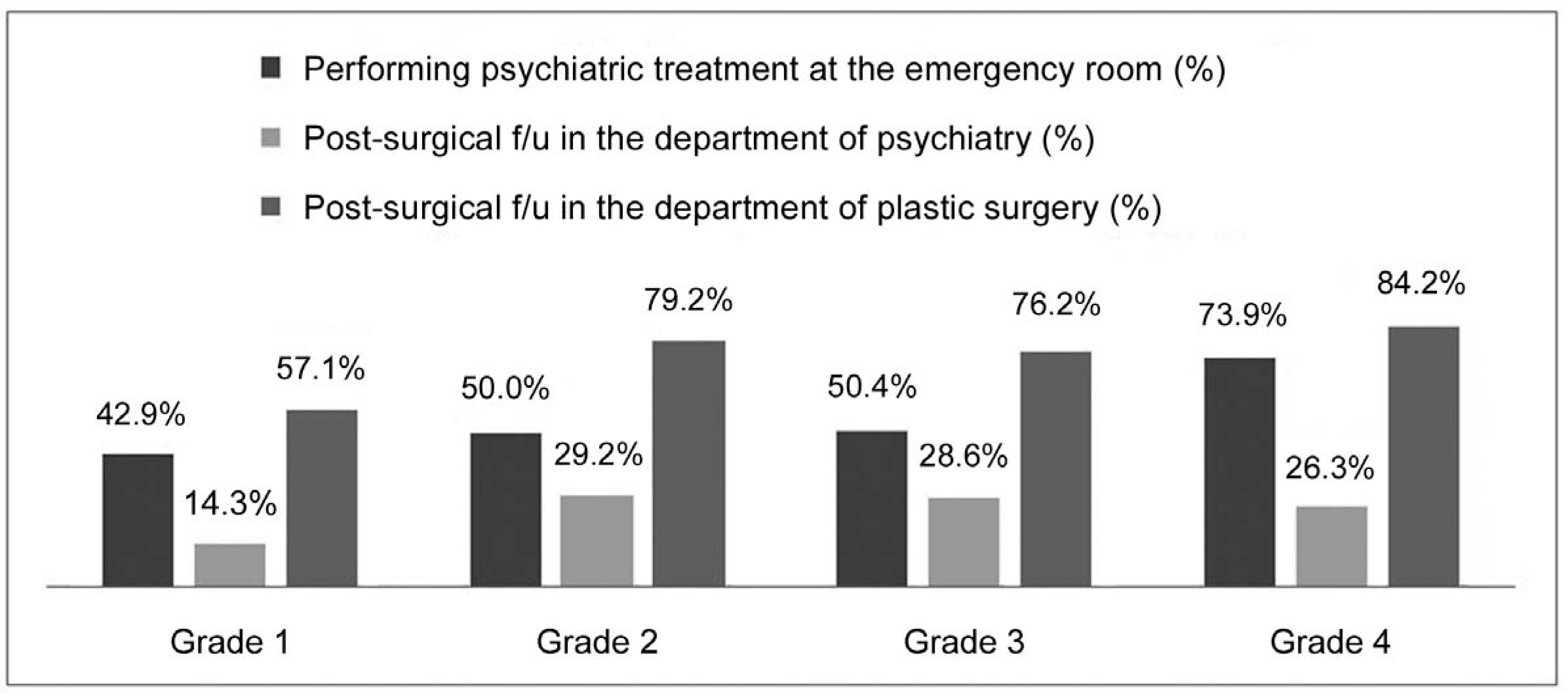Abstract
Purpose:
Self-inflicted wrist laceration is a common injury in the department of hand surgery. The aim of this study was to investigate the clinical characteristics and psychiatric features of self-inflicted wrist laceration using categorization according to wound severity.
Methods:
We reviewed 71 patients from 2002 through 2012. All of the patients were grouped into four groups. Data regarding the following characteristics were collected: age, gender, size, structure involved, instruments used, history of previous self-inflicted injury, comorbidities in psychiatric and presentation of follow-up outpatient appointment to the department of plastic surgery and psychiatry.
Results:
In these patients, approximately 64% of patients were female. About 80% of patients cut their wrist using a knife. And in grade 3-4 injury, percentage of glass injury was relatively high (22%), compared with other grades (3%). Unlike previous studies, patients in grade 3-4 tended to cut their wrist repeatedly. Focusing on psychiatric problems, approximately one quarter of patients had a previous history of self-infliction. In all patient groups, mood disorder was the most common disorder in patients who had a previous psychiatric disorder. But after operation, more than two thirds of patients had not visited department of psychiatry again.
Conclusion:
We identified some other differences among their characteristics. All patients in group also should be evaluated and surgically treated properly. A multidisciplinary approach is required for patients with wrist laceration due to self-injury in comparison to those with laceration due to other causes. Because many of them have previous self-injury experiences and psychiatric disease.
Go to : 
References
1. Fujioka M, Murakami C, Masuda K, Doi H. Evaluation of superficial and deep self-inflicted wrist and forearm lacerations. J Hand Surg Am. 2012; 37:1054–8.

2. Maloney C, Shah S, Ferguson DG. Acute management of the self-cutter. Arch Emerg Med. 1987; 4:39–45.

3. Rashid A, Brennen MD. Psychiatric assessment of patients with self-inflicted lacerations to the wrist and forearm admitted to a nonpsychiatric ward: the experience of a regional plastic surgery unit. J Plast Reconstr Aesthet Surg. 2006; 59:266–71.

Go to : 
 | Fig. 1.Previous history of self-inflicted wrist laceration patients (%): approximately one quarter of patients had a previous history of self-infliction. |
 | Fig. 2.Psychiatric and plastic surgery department follow-up arrangements (%): after operation, more than two thirds of patients had not visited department of psychiatry again. f/u, follow-up. |
Table 1.
Grade of self-wrist laceration by injury depth and related anatomy
| Grade | Involvement structure |
|---|---|
| Grade I | Skin alone |
| Grade II | Skin, PL, FCR |
| Grade III | Skin, |
| PL, FCR | |
| FCU, artery and nerve | |
| Grade IV | Skin, |
| PL, FCR | |
| FCU, artery and nerve | |
| FDS and FDP |




 PDF
PDF ePub
ePub Citation
Citation Print
Print


 XML Download
XML Download